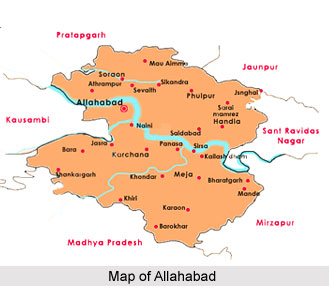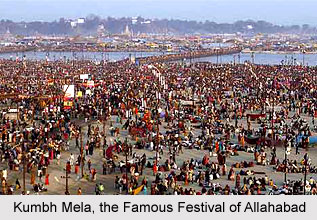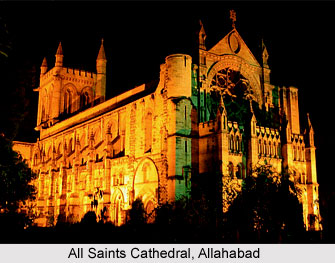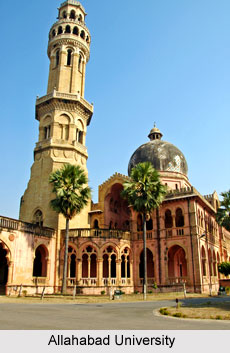 Allahabad is also called `the city of Prime ministers since it has produced as many as seven prime ministers after its independence. The term `Prayag` means, `the place of offerings`. The sacred union of the three rivers Ganga, Yamuna and the invisible Sarasvati make Allahabad one of the most revered Indo-Aryan cities in the nation. The confluence of the three Indian rivers, called `Triveni Sangam` is considered sacred and visited by innumerable tourists. Every twelve years, numerous pilgrims throng this holy city to offer their prayers. Allahabad is India`s second oldest city and boasts of several temples and palaces. Originally, the city was called Kaushambi, though later its name was changed to Pratisthanpur.
Allahabad is also called `the city of Prime ministers since it has produced as many as seven prime ministers after its independence. The term `Prayag` means, `the place of offerings`. The sacred union of the three rivers Ganga, Yamuna and the invisible Sarasvati make Allahabad one of the most revered Indo-Aryan cities in the nation. The confluence of the three Indian rivers, called `Triveni Sangam` is considered sacred and visited by innumerable tourists. Every twelve years, numerous pilgrims throng this holy city to offer their prayers. Allahabad is India`s second oldest city and boasts of several temples and palaces. Originally, the city was called Kaushambi, though later its name was changed to Pratisthanpur.
History of Allahabad
The name Allahabad was obtained in the year 1583, when the Mughal emperor Jalal al-din Muhammad Akbar transformed its name. In Hindi, its name is `Illahabad`, wherein `Illah` means God in Arabic and `abad` in Persian which implies to manufacture or to build`. Therefore Allahabad means, `city of God`. Hindu mythology states that at the commencement of creation, Lord Brahma chose a particular region on earth to perform a sacred ritual, known as `Prakista Yag`. Lord Brahma, who is worshipped by Hindus as the Lord of Trinity (Tridev-Brahma, Vishnu and Maheshwara), had referred Allahabad as `Tirth Raj`, meaning, `the king of all pilgrimage spots`.
Several ancient Indian holy texts like Vedas, Puranas, Ramayana, and Mahabharata have mentioned about Allahabad. According to the Puranas, King Yayati (Puranic king and son of King Nahusha) had abandoned Prayag and invaded the region of `shapta-sindhu` (seven rivers existent in Rig Veda comprising Sutudri, Parusni, Asikni, Vitasta, Vipas, Saraswati and Sindhu). Ramayana asserts the existence of a holy confluence of three rivers where sages build their huts. It was this very place where Lord Rama had spent sometime at the `Ashram` or residence of Sage Bhardwaj before progressing towards Chitrakoot. After the Aryans settled in India, Allahabad formed a significant portion of their empire which they called `Aryavarta`. Prayag finds a mention in the verses of the ancient poet Kalidasa`s epic poem, `Raghuvansham`.
In medieval times, Allahabad became an important part of Delhi Sultanate, after it was annexed by Mughal emperor Mohammad Ghori. Allahabad possesses a beautiful fort on the banks of the holy Triveni Sangam, known as Allahabad Fort, which was built by Akbar, and is a fine example of architectural grandeur. There are historical accounts about the visit of Chinese traveler Hieun Tsang during the regime of King Harshavardhana.
During British Raj, Allahabad was the epicenter of Sepoy Mutiny in 1857. The then viceroy Lord Canning shifted the capital of north-west frontier provinces (NWFP) of India to Allahabad, from Agra. This city was the British capital of NWFP from 1901 to 1949. It also contains `Anand Bhavan` and `Swaraj Bhavan`, the homes of Nehru family which were once the nerve-centers of Indian National Congress.
 Geography of Allahabad
Geography of Allahabad
Allahabad is located at the southern part of Uttar Pradesh and is 238 km away from the state capital Lucknow. The total area of the city measures about 63.07 sq km. Bundelkhand region surrounds Allahabad in the south-west, while its south-east portion is flanked by Baghelkhand region. Awadh is situated on the north and north-east side of the city. A railway line runs throughout the middle of the city. The Old Chowk lies to the south of railway line and the Civil Lines is located to the north. Allahabad is strategically placed as a major part of it lies in the Doab region which is the last point of the Yamuna River. River Ganga flows along the eastern edge of the city.
Climate in Allahabad
Allahabad experiences an extreme climate. The three main seasons are summer, winter and monsoon. Summers and winters are typically hot while monsoons are humid. Summer remains for three months, starting from April to June. During this period, maximum temperatures exceed forty degrees, particularly in May and June. Monsoons arrive in July and leave in September. December to February witnesses freezing winters. August receives the maximum quantity of rainfall, approximately 296 mm.
Flora and Fauna in Allahabad
Since Allahabad is situated on the western side of the Indo Gangetic plain, it possesses a variety of unique species of biodiversity. Several species of flora and fauna have become extinct or endangered, as a consequence of human inhabitation. There are snakes and other reptiles, mammals, and plenty of birds like peacocks, house sparrows, parakeets, bulbuls, songbirds, doves, junglefowls amongst numerous other birds. Large birds like eagles have become extinct in this region.
Demography of Allahabad
According to the population census of India 2011, Allahabad has a population of 5,959,798. It recorded the highest literacy arte in 2011, which is 74.41%. Generally, Hindi, Urdu, English, Awadhi and Khariboli are spoken in Allahabad.
 Culture of Allahabad
Culture of Allahabad
Allahabad is reputed for being one of the dominant focal points of literary, religious and artistic traditions. Indian holy scriptures like Ramayana, Mahabharata, Puranas and Vedas spoke extensively about this place, imparting deep religious significance to this city. Inhabitants of Allahabad spend a considerable amount of time performing many holy rituals and spiritual activities. Hindu ladies wear the saree and salwar kameez. However, western outfits are preferred by young men and women. Men usually wear `sherwanis` during festivities and social occasions. One will come across several buildings inspired by Indo-Islamic and Indo-Saracenic motifs.
This city became the pivotal point where Hindi literature flourished and gave birth to many authors like Harivansh Rai Bachchan, Mahadevi Varma, Suryakant Tripathi and many more noted writers and poets.
Allahabad is famous for its celebration of Kumbh Mela every twelve years and `Ardh` (half) kumbh mela every six years. The city draws the world`s largest congregation during Kumbh Mela. Hindus consider that bathing in the holy waters of the confluence of rivers Ganga and Yamuna, during Kumbh Mela purifies the body, mind and soul. The pilgrims visit Allahabad during the Hindu month of `Magh`, which lasts from mid January to mid February.
Religion in Allahabad
Hindus constitute the highest community in Allahabad, measuring close to 73%. They are closely followed by Muslims who comprise 235 of the city`s population. Jains and Christians form the remaining other religions in Allahabad.
Sports in Allahabad
The two most popular sports in Allahabad are cricket and field hockey. In the rural regions, games like Kabaddi, Kho-Kho, Gilli Danda are usually played. Youngsters play `gully cricket` in the lanes and streets of Allahabad. The city consists like of a few sports complexes which are utilized by amateur players as well as professional players. Madan Mohan Malviya cricket stadium and Amitabh Bachchan Sports Complex are some of the important sports stadiums.
Transport system of Allahabad
Allahabad is equipped with an airport and a network of railways lines which connect the city to other Indian cities like Kolkata, New Delhi, Mumbai, Chennai, Hyderabad, Indore, Bhopal, Lucknow and Jaipur. The simplest mode of transportation here is the taxi. Besides taxis, one can also commute by buses which are maintained by Uttar Pradesh State Road Transport Corporation (UPSRTC).
Education in Allahabad
The city includes schools which are operated by government and also private organizations. Allahabad is an important educational hub which interests students from across India. Allahabad University is one of the oldest educational institutions in the nation. It is a central university. The city has four deemed universities and a single open university (autonomous university). Some universities in Allahabad which are held in high esteem are as follows:
| Motilal Nehru National Institute of Technology (MNNIT) |
| Motilal Nehru Medical College |
| Uttar Pradesh Rajarshi Tandon Open University (UPRTOU) |
| Infinity Institute of Technology, Reewa Road, Allahabad (IIT-Allahabad) |
| Harish Chandra Mehta Atomic Research Institute |
| Indian Institute of Information Technology Allahabad (IIIT-A) |
| Sam Higginbottom Institute of Agriculture, Technology and Sciences (SHIATS) |
| Ewing Christian College (ECC) |
| Birla Institute of Technology |
| Civil Aviation Training Centre |
Economy in Allahabad
The economy in Allahabad is prosperous. It was announced as the 130th fastest growing city in the world in 2011, with as many small and large scale industries. There are 58 large scale industrial units and over 3,000 small industries in the city. Tourism, horticulture and fishing form the vital industries of Allahabad. A few essential industrial organizations in Allahabad are:
| ITI Naini |
| Geep Indistries |
| Raymond Synthetics Karchanna |
| Hindustan Cable Ltd Naini |
| Triveni Sheet Glass Ltd Naini |
| IFFCO (in Phulpur region of Allahabad) |
 Tourism in Allahabad
Tourism in Allahabad
Every year, millions of tourists and devotees visit Allahabad, lured by the multiple tourist destinations in the city. One must make it a point to visit the Sangam, or the intersection of the rivers Ganga and Yamuna,
Allahabad Fort, Allahabad Museum, Anand Bhavan, Jawahar Planetarium,
Patalpuri Temple, Khusro Bagh, Ashoka Pillar, Sai Dham Mandir, Hanuman Mandir,
Mankameshwar Mahadev Shiv Mandir, Shivkoti Mahadev Temple, Someshwar Mahadev Temple, Maa Kalyani Mandir, Minto Park (also known as Mahamana Madan Mohan Malaviya Park),
Chandra Sekhar Azad Park, Company Garden (Alfred Park),
All Saints Cathedral (Patthar Girjaghar) and Akshaya Vat.
Other places of interest in the city are New Yamuna Bridge, Pratisthan Pur (located at Jhunsi), Maharshi Safaldeo Ashram (
Jhunsi), Bhardwaj Ashram, Saraswati Ghat,
Mayo Memorial Hall, Allahabad University and the Public Library. Tourists will come across numerous hotel accommodations which offer dining, lodging and recreational facilities in Allahabad. Allahabad has been chosen by the
Government of India as one of the mission cities for
Jawaharlal Nehru National Urban Renewal Mission. Indian government has stated that Allahabad is a model city in terms of meeting the goals of urban development, efficient administration and granting basic amenities to its citizens.
Food and delicacies in Allahabad
Travellers may indulge in sumptuous delicacies of Allahabad like `
motichoor laddoo`, `besan laddo`, `
barfi`, `rabri`, `
kulfi`, `kachauris` and Mughlai cuisine of North India.
The sacred city of Allahabad has produced many reputed personalities in the fields of music, literature, academics, films and also politics. India`s first Prime Minister Jawahar Nehru, classical music vocalist
Shubha Mudgal and Amitabh Bachchan are only a few of the vast number of celebrities who belong to Allahabad. -This city was a significant landmark of India even during the British period, as is evident from some of its
colonial architecture in many buildings. Allahabad is a diverse city which possesses manifold facets of cultures, historic traditions, customs and religious rituals.
 Allahabad is also called `the city of Prime ministers since it has produced as many as seven prime ministers after its independence. The term `Prayag` means, `the place of offerings`. The sacred union of the three rivers Ganga, Yamuna and the invisible Sarasvati make Allahabad one of the most revered Indo-Aryan cities in the nation. The confluence of the three Indian rivers, called `Triveni Sangam` is considered sacred and visited by innumerable tourists. Every twelve years, numerous pilgrims throng this holy city to offer their prayers. Allahabad is India`s second oldest city and boasts of several temples and palaces. Originally, the city was called Kaushambi, though later its name was changed to Pratisthanpur.
Allahabad is also called `the city of Prime ministers since it has produced as many as seven prime ministers after its independence. The term `Prayag` means, `the place of offerings`. The sacred union of the three rivers Ganga, Yamuna and the invisible Sarasvati make Allahabad one of the most revered Indo-Aryan cities in the nation. The confluence of the three Indian rivers, called `Triveni Sangam` is considered sacred and visited by innumerable tourists. Every twelve years, numerous pilgrims throng this holy city to offer their prayers. Allahabad is India`s second oldest city and boasts of several temples and palaces. Originally, the city was called Kaushambi, though later its name was changed to Pratisthanpur.
 Geography of Allahabad
Geography of Allahabad
 Culture of Allahabad
Culture of Allahabad
 Tourism in Allahabad
Tourism in Allahabad



















